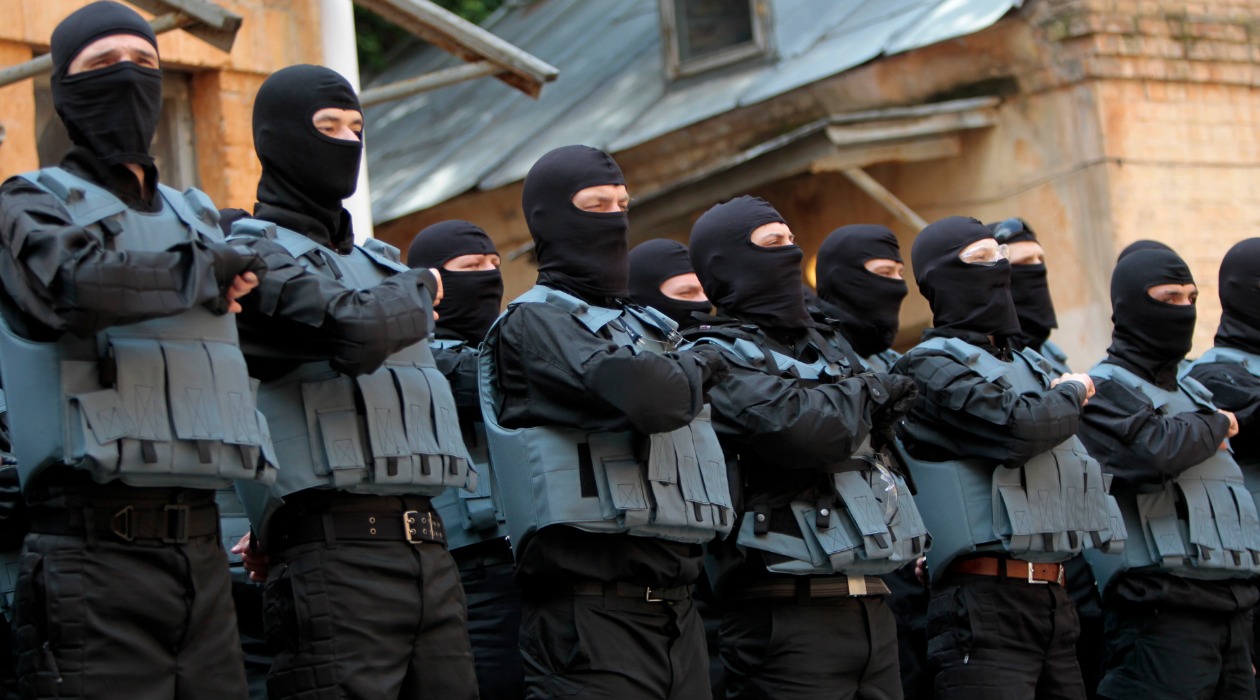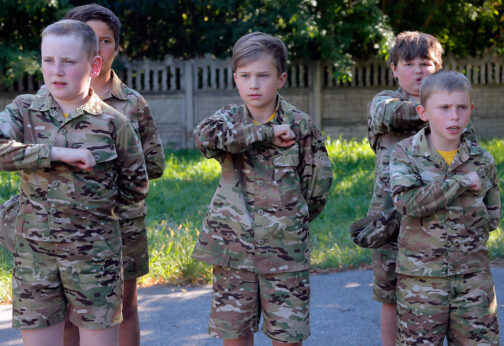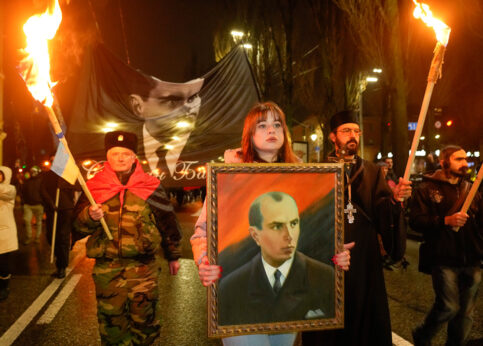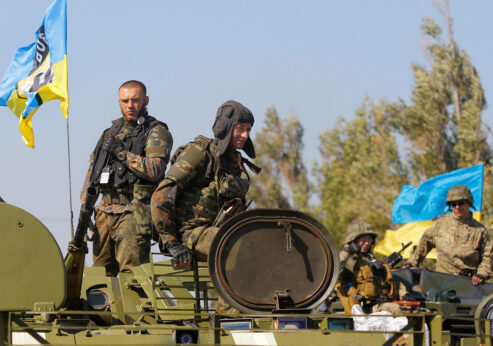
There’s an increasingly surreal air regarding the war scare over Ukraine.
The original roles in the drama seem to be reversed. Back in December, Ukrainian Foreign Minister Oleksii Reznikov was warning that “not provoking Russia—that strategy does not and will not work,” claiming that Russia invaded Georgia in 2008 because NATO hadn’t let it join. In fact, Georgia began that war by attacking South Ossetia, driving tens of thousands of Russian-speaking residents there to flee across the border into Russia, creating an unprecedented refugee crisis for that country. These details, however, rarely trouble Western politicians or journalists.
In December, the U.S. seemed much more reluctant to escalate matters. President Joe Biden said he would not deploy troops to Ukraine, and ruled out a military response to any Russian incursion. The same mood music emanated from Westminster, where U.K. Defense Secretary Ben Wallace said that British troops would not fight Russia over Ukraine, as the latter was not a NATO member. If Russia did act against Ukraine (and we should remember that it has not at any point threatened to), the U.S. and E.U. response would be sanctions.
As of last weekend, Reznikov was assuring members of the Ukrainian parliament that actually no Russian military maneuvers had been observed, that there was nothing more threatening happening than what was going on a year ago, and that there was no reason to fear an imminent attack.
Ukrainian President Volodymyr Zelensky gave an even blunter press conference following a phone call with Biden, calling on the U.S. and Britain to tone down their rhetoric about an invasion, since it could create panic and was bad for business.
Asked about the U.S.’s claim that Russia might invade next month, he snapped that, as Ukraine’s head of government, he knew the situation better than Biden. He even cast doubt on the idea that Russia’s military build-up necessarily had anything to do with Ukraine, saying we had no way of knowing it wasn’t a routine troop rotation.
We know, of course, that what really worries the Russians is what the U.S. and NATO have been doing ever since the demise of the Soviet Union. They have been moving Western troops and armaments into one eastern European country after another until now that troops and even offensive missiles are aimed at Russia from places right along that country’s borders.
But did Washington and London heed Zelensky’s pleas? They didn’t even acknowledge them.
Biden has ordered the deployment of 3,000 extra troops to Europe (where the U.S. already has tens of thousands of troops, and NATO has forward bases in Poland and all three of the Baltic states). All of this is in violation of promises made by the U.S. at the end of the Cold War that NATO would not make any moves to the east. Among the troops Biden is sending are 1,000 to Romania, where the U.S. has offensive cruise missiles pointing at Russia. Controls on U.S. placement of such offensive weapons were lifted in 2019 when the Trump administration unilaterally cancelled the INF Missile Treaty with Russia.
Adding to the provocative announcement by Biden regarding 3,000 new troops, British Prime Minister Boris Johnson pledged “land, sea, and air” forces would be sent to eastern Europe to see off the Russian menace.
The more Ukraine insisted last week that it is not afraid that war is coming, the louder the U.S. and Britain declared their readiness to fight one.
The same buildup of war hysteria can be seen in how the U.S. and NATO have handled announcements regarding alleged findings by U.S. and Western “intelligence.”
First we heard that the Russians had massed 100,000 troops on Ukraine’s borders, and for weeks satellite photos of the same rows of snow-covered tanks were fed to the Western media to “verify” these reports. An invasion is “imminent,” we were told. Soon feeding the press the same old photos was not enough.
When the invasion didn’t happen, the New York Times said that it had word from sources in the Pentagon that the number of troops had to reach 175,000 or more before an invasion began. This information supposedly came from Western “intelligence” sources. By announcing the supposedly “secret” plans by Russians to send more troops before any invasion, but never quite seeing the “175,000 or more” level actually being reached, there was room now for stretching out the timing of the alleged “imminent” invasion.
Several weeks later, again to hype up the expectation of imminent invasion which still had not arrived (we weren’t up to 175,000 yet), we heard that we could expect a “false flag attack” whereby Russia would stage an attack on itself in order to justify an “imminent” invasion.
When, again, the false flag attack triggering the “imminent” invasion also did not happen, there emerged a new story—that there was a “plan” to install a pro-Russian government in power in Kiev. That report supposedly was passed to the Pentagon by British intelligence.
The only time a “pro-Russian” government assumed power in Kiev since the demise of the USSR was when the Ukrainian people elected such a government themselves and that government, in 2014, after it re-buffed IMF austerity demands that should be imposed on the Ukrainian people, was overthrown in a fascist coup backed by the U.S. Nevertheless, no “pro-Russian” government has been installed in Kiev since the announcement weeks ago by the West that Russia had such a puppet plot.

Now, another version of the false flag story is circulating. At mid-day Thursday, “news” broke that the U.S. had acquired intelligence that Russia was planning to stage and film a fake attack by Ukrainian forces either on Russian territory or Russian-speaking people in eastern Ukraine. According to the Times, it would have been a production worthy of Hollywood:
“The video was intended to be elaborate, officials said, with plans for graphic images of the staged, corpse-strewn aftermath of an explosion and footage of destroyed locations. They said the video was also set to include faked Ukrainian military equipment, Turkish-made drones and actors playing Russian-speaking mourners.”
In making the alleged scheme public, the U.S. declared it hoped “to spoil” the Kremlin’s plan. U.S. officials, of course, released no direct evidence of their allegation and declined to name the source of their supposed discovery.
One thing about all these provocative announcements about “intelligence” findings that requires very little intelligence to figure out, however, is that each one of these so-called revelations is part of a bigger strategy on the part of the West.
Unfortunately, it is exactly the strategy one would use to spur the Russians into taking an action that would justify imposing strong sanctions. On Wednesday, former U.S. Ambassador William Taylor called for such sanctions immediately, saying the U.S. should not wait for any actual invasion. He said he also supported Biden sending in troops now rather than waiting for any Russian moves.
Most ominous regarding in Biden’s troop buildup, however, is the fact that his decision followed a speech by Putin in which the Russian leader, notably, did not even repeat his prior demands that in order to end the crisis the U.S. and NATO had to remove all their troops from former member nations of the Warsaw Pact.
Putin also did not repeat earlier demands that all U.S. nuclear weapons be removed from Europe, including and especially the nuclear missiles the U.S. has in Germany. Omission of these demands by Putin should have been taken as a point from which negotiations could proceed, not, as they were, as a point from which the U.S. escalates war tensions even more.
War—whether anyone wants it or not
Could all of this mean that we are perhaps dealing only with a shadow-boxing match? Russia deploys troops near its western border and conducts exercises with Belarus to lend weight to security demands it put to the U.S., such as a mutual commitment not to station nuclear warheads outside their own territory.
The U.S., meanwhile, ramps up the fear of Russia in order to press longstanding aims such as killing the Nord Stream 2 pipeline, which it says would pose a security risk by increasing European dependence on Russian gas (and the cancellation of which would, conveniently, force Europe to purchase gas elsewhere—when the U.S. is trying to increase fracked shale gas exports).
Ukraine is also keen to stop Nord Stream 2, since it would lose transit fees for Russian gas currently piped through its territory. Ukrainian state energy firm NAFTOGAZ estimates losses at $3 billion a year if the new pipeline becomes operational.
This could explain why Zelensky, while downplaying the threat of war on Saturday, did call for sanctions on Nord Stream 2 regardless of whether Russia attacks or not.
If this is true, Ukraine’s about-turn reflects its fear that the situation is getting out of hand: An initial policy of talking up the threat to derail the pipeline and get access to advanced weaponry has snowballed to the extent that it might actually start a war, which would clearly be catastrophic for the whole of Europe but most of all for Ukraine. But if neither side actually wants war, what is there to be afraid of?
The answer is that this military posturing is extremely risky, and does significantly increase the chance of a conflict breaking out.
This is true for all the traditional reasons—moves pitched as deterrence by one side can be interpreted as belligerence by the other, and the West has the proven track record of “goading” Russia with air and sea deployments along its borders. As Guardian columnist Simon Jenkins observed a few weeks ago, “the invitation to Moscow to call [the] bluff is glaring.”
More than once in the original Cold War, misunderstandings came close to sparking nuclear conflict, which was averted by the courage and calm of individuals on the front line. Few in the U.S. Congress or the British Parliament, for example, seem to grasp this risk.
But with Ukraine, the risks are enormously multiplied. This is because the war in the Donbass means that fighting does not even have to “break out” in the ordinary way: It could be said to be happening already.
And the nature of that war means a new outbreak might not even be under control from Moscow or Kiev or Washington.
Nazis in the Donbass
The self-governing separatist People’s Republics of Donetsk and Lugansk are backed by Russia, but their forces are not part of the Russian army.
On the other side of the trenches the situation is even more complex. The Western media, particularly in Europe, has gushed over the heroic “volunteers” manning the battle lines for Ukraine in the Donbass, even running interviews with ex-soldiers from the West “contracted” to fight for Ukraine (that is, mercenaries).
Kiev’s forces in the Donbass war are by no means all regular soldiers. Far-right forces were the foot soldiers of the 2014 Maidan coup that provoked the conflict, and have been on the front lines ever since.
Most notorious is the Azov Battalion, a neo-Nazi unit formed from ultras from the Metalist Kharkiv football club in 2014. Its founder, Andriy Biletsky, is an unsubtle fascist, having called on Ukraine to lead a crusade of the “white races” against the “Semite-led untermenschen.”
Ukraine’s Interior Ministry authorized the formation of paramilitary battalions that year, and Azov was one. Another, the Aidar Battalion, formed the same year, also has far-right ideological associations.

These fascist units are allowed a cloak of respectability by Ukraine’s rehabilitation of Nazi collaborator Stepan Bandera and rewriting of history to portray genocidal organizations like his Ukrainian Insurgent Army, which played a major role in the Holocaust, as anti-Soviet patriots.
People’s World in the U.S., Morning Star in the U.K., and other newspapers are sometimes accused of exaggerating the fascist character of the 2014 coup in Ukraine and its aftermath, since the Kiev government itself is not overtly fascist. But the turning over of police and military units to fascist control by the regular Ukrainian government speaks volumes about the power of fascists in Ukraine. And the current government itself glorifies actual fascists like Bandera. Then, of course, the current government is guilty in the very least of having the bad taste of marches through the capital commemorating regiments of the Waffen SS.
By autumn 2014, Amnesty International was warning the Ukrainian government that it had documented war crimes “including abductions, unlawful detention, ill-treatment, robbery, extortion, and possible executions committed by the Aidar Battalion” in the Donbass.
The mother of one separatist fighter reported the head of her son being mailed to her in a box following his capture by “white nationalist paramilitaries.” Yet that September, the Azov Battalion was formally enrolled in the National Guard of Ukraine.
Enter the mercenaries
Are these the forces that Western “volunteers” or mercenaries are signing up with? Certainly they have tried to recruit foreigners in the past. Hope Not Hate warned in 2018 that the Azov Battalion was working with a British group called the Misanthropic Division to recruit far-right British activists to travel to Ukraine to fight.
Ukrainian Communist Party leader Petro Symonenko says foreign mercenaries are allowed to sign up with the Ukrainian military as a matter of course, and it is not just units like Azov which recruit them.

“After the 2014 coup, Ukraine has turned into a sump of neo-Nazis from around the world. In the Donbass, there are mercenaries from many countries as part of the volunteer battalions,” he tells me, “including the U.K.
“In addition to the ideological Nazis you have the ‘human safari’ scum, who see the war in the Donbass as a kind of extreme entertainment.
“Then you have the private military companies—fighters and instructors from Letera-43 from Italy, Halo Trust, Greystone, ‘Academi’ (known as Blackwater before 2009) from the U.S. and others. And there are a lot of official instructors from NATO countries—the U.S., Britain, Canada, and so on.”
Leaving aside the risks to people back at home of allowing these mercenaries to travel to warzones to fight alongside known extremists—we saw the potential consequences when a fighter, returned from the NATO-backed war to overthrow Gaddafi in Libya, killed 22 people in the Manchester Arena terror attack in 2017—the picture is explosive.
Ukraine’s militarized Donbass border swarms with professional soldiers, neo-Nazi paramilitaries, trigger-happy adventurers and “war tourists,” mercenaries, NATO “advisers,” and, thanks to the recent war scare, there’s a growing direct Western military presence.
It would not take much to light this tinderbox and quite a few of the unsavory characters in that mix would not be averse to doing so.
That is why the only sane approach to this crisis is de-escalation. The governments of the NATO countries must be pressed to withdraw troops from Ukraine and stop loading up an army bristling with “volunteers” with heavy weaponry.
Talks with Russia and Ukraine on reviving the Minsk peace process have to be revived, as Putin requested in Moscow this week. The U.S. and NATO must cease their dangerous brinksmanship.
This article includes an edited version of an article by Ben Chacko that appeared in the Morning Star.











